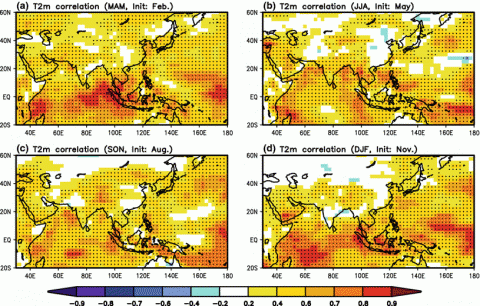This paper describes the operational seasonal prediction system developed by the Japan Meteorological Agency (JMA), the Japan Meteorological Agency/Meteorological Research Institute-Coupled Prediction System version 1 (JMA/MRI-CPS1), which has been in operation from February 2010 to May 2015. The predictive skill of the system was assessed with a set of retrospective seasonal predictions (hindcast) covering 30 years (1981-2010). The results obtained indicate the usefulness of JMA/MRI-CPS1 (which has shown similar skill to other state-of-the-art systems), especially for the East Asian region.
For 3-month predictions with a 1-month lead, JMA/MRI-CPS1 showed statistically significant skills in predicting 500-hPa geopotential height and 2-meter temperature in East Asia in most seasons. The relatively high predictive skill for East Asia compared with the other regions in the same latitudes is attributed to successful reproduction of teleconnections associated with ENSO and SSTs in tropical basins.
At the moment, JMA/MRI-CPS1's forecasts are only available for national meteorological services.
- Takaya, Y., Yasuda, T., Fujii, Y., Matsumoto, S., Soga, T., Mori H., Hirai, M., Ishikawa, I., Sato, H., Shimpo, A., Kamachi, M. and Ose, T.: Japan Meteorological Agency/Meteorological Research Institute-Coupled Prediction System version 1 (JMA/MRI-CPS1) for operational seasonal forecasting, Climate Dynamics, 48 (1), 313-333, doi:10.1007/s00382-016-3076-9, 2017.

